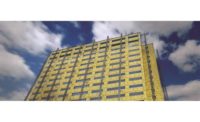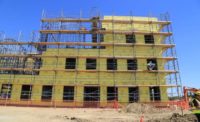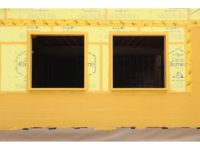In commercial new construction, designing with an eye toward fire safety is of the utmost importance. Everything from electrical plans to building egress are built on a foundation of either preventing fires from starting in the first place, or limiting flame spread and keeping occupants safe if one does. Failure to comply with fire-related building codes can be disastrous. The UK’s Grenfell Tower disaster in 2017 exemplifies the tragic results of eschewing fire codes.
Building material selection plays an important role in these fire safety efforts. Even in commercial buildings that incorporate active fire suppression systems, both interior and exterior wall assemblies are essential for preventing flame spread and increasing egress time for occupants.
While there is a lot at stake when it comes to wall assembly performance, the commercial architect, engineer, and construction (AEC) community can still look for materials that achieve International Building Code (IBC)-required fire ratings as efficiently and reliably as possible. While masonry walls and cement board are acceptable options for fire-rated wall assemblies, gypsum panels are the ideal choice in both interior and exterior applications.
When is Fire Resistance Required?
For interior walls, the IBC calls out three types of fire-resistant wall assemblies. Each assembly type must pass ASTM E119, which determines the fire resistance of the entire assembly, and is issued a fire-resistance rating, noted in hours. This hour rating measures the period of time that the wall assembly maintains its ability to confine a fire and/or continues to perform its structural function in a test or evaluation.
|
Assembly Type |
Hour Rating |
Common uses |
|
Fire Partition |
1 hour |
These interior walls are used to separate specific rooms within a building, such as between shopping mall tenants, dwelling units, or hotels guest rooms. |
|
Fire Barrier |
1 - 4 hours |
These assemblies are commonly used in atriums, interior exit stairways, exit stairway enclosures and passageways, and shaft enclosures. |
|
Fire Walls |
2 - 4 hours |
These most restrictive fire-rated assemblies effectively create separate buildings based on allowable area. |
For exterior walls, fire resistance ratings generally range from 0 to 3-hour assembly ratings, and are determined by construction type, interior occupancy, and fire separation distance. Exterior walls that are 10 feet or less from the property line must have a fire-resistance rating based on their proximity to adjacent buildings and interior occupancy conditions. This is especially important as infill development continues to grow. As more structures are built closer together, the AEC professionals can expect to see increased need for exterior wall assemblies that perform in the 2-hour-or-higher level for fire ratings.
Of course, because actual fires vary both from test conditions and from fire to fire, hour ratings are not representative of actual fire conditions. An assembly having a “one-hour” fire rating, for example, will not necessarily withstand the effects of an actual fire for one hour. In the event of an actual fire, persons should immediately take necessary actions for their safety without regard for the hour rating.
Other construction industry trends are also creating an increased demand for fire wall assemblies. For example, as post-Covid recovery begins, the multifamily market is expected to see a 33 percent uptick in investment activity. Multifamily dwellings, along with hotels and dormitories, are prime examples of buildings in which fire partition and barrier walls are an essential part of construction. As the market grows, so will use of these assemblies.
Type X Vs. Type C Gypsum
With the demand for fire-rated wall assemblies growing, identifying the best components to comprise them is essential. Thanks to their inherent fire resistance, gypsum panels rise to the top as a sheathing component in ASTM E119-tested assemblies, and there are two types of panels with increased fire resistance beyond regular gypsum panels that accomplish this goal: Type C and Type X.
Type C panels are designed with interior use in mind, specifically for walls, ceilings, soffits, etc. These 1/2- and 5/8-inch panels incorporate an additive that prevents shrinkage and allows the panels to expand when exposed to heat. Type X panels and shaftliners, available in 5/8 and 1-inch thicknesses, can are designed to be used in interior or exterior walls and other fire barrier assemblies, such as area separation walls, shaft enclosures, and stairwells.
Both Type C and Type X gypsum boards are non-combustible, per classification at the materials level under ASTM E136, and both are formulated to strengthen the boards for longer-lasting structural integrity when exposed to heat and flame. It’s important to note that wall assembly designers can use 5/8-inch Type C gypsum in place of 5/8-inch Type X panels in most instances, but Type X cannot be used to replace Type C.
Gypsum Helps Achieve Code Compliance
Most fire-rated gypsum panel manufacturers have thorough databases of approved ASTM E119 or UL 263 wall assemblies. As called for by the IBC, the testing criteria for walls in many assembly tests and where a finished rating is listed for wood framed construction designs that the assembly
- Sustain an applied load.
- Have no passage of flame or gas hot enough to ignite cotton waste.
- Have an average temperature rise on unexposed surface not more than 250F above any initial temperature, or more than 325F at any point for wood framed construction (finished rating).
- Have no water pass through during hose stream test.
By design, both ASTM E119 and UL 263 use the same testing criteria. This allows the results of the tests to be reproduced, compared, and applied across any testing facility. With this in mind, architects and engineers can feel confident in using manufacturer databases to identify the best solutions for their building needs, including assemblies that use Type X or Type C gypsum. In all cases, the wall assemblies are hour rated by third parties.
Beyond IBC, National Fire Protection Association (NFPA) testing criteria are also essential considerations for fire-rated wall assemblies. As mentioned earlier, close building proximity requires architects and designers to consider potential flame spread to neighboring buildings, as specified in NFPA 268. Simultaneously, NFPA 285 looks at flame spread from one story to another, drawing attention to combustible materials such as water-resistive barriers (WRB) and air barriers (AB) used on the exterior of any high-rise building.
Because of NFPA 285, combustible WRB/AB layers used in wall assemblies can often create a roadblock to achieving code compliance. Thankfully, some gypsum manufacturers can help builders overcome this issue. By selecting integral WRB gypsum sheathing panels that are ASTM E136-compliant, builders can create wall assemblies that meet or exceed all necessary fire-related codes, while simultaneously simplifying installation. Eliminating the extra steps of separate WRB/AB installation, combined with the gypsum’s inherent fire resistance, helps to provide an easy and economical path to compliance.
Practical Advantages of Gypsum in Fire-Rated Assemblies
In addition to code compliance, gypsum provides a number of advantages over other fire-resistant options, including masonry walls or cement board for both interior and exterior fire-rated assemblies.
Masonry walls are inherently more labor intensive than gypsum panels. In addition to the skilled labor hours and cost associated with masonry wall construction and cure time, concrete masonry unit (CMU) walls may absorb and hold water if not properly built and protected from moisture intrusion. These problems compromise the integrity of the building and the protection the wall provides and can be difficult to fix if they do occur.
Like CMU masonry walls, poured concrete or cast-in-place walls can also help meet required fire ratings, but come with disadvantages of their own. A successful on-site concrete pour is heavily dependent upon weather conditions, the mix of the concrete itself, and the installers’ skill. Once poured, cast-in-place walls require a minimum cure time of seven days in temperatures above 40F. This is a significant amount of unused production time on jobsites where getting buildings occupant-ready as efficiently as possible is key.
Using fire-rated gypsum helps alleviate these concerns. Standard-size 4x8- to 4x14-foot sheets make gypsum panels a much more labor-friendly option than masonry wall construction. The materials are familiar for any installation crew to work with and do away with mortared joints that can deteriorate over time. Additionally, some 5/8-inch fire-rated gypsum panels weigh around 2lb per square foot, compared with 2.5 lb/sf for average 1/2-inch cement board options, or upwards of 30 pounds per CMU for a masonry wall depending on the block manufacturer. This means gypsum can allow engineers and builders can achieve a substantial wall assembly—potentially exceeding required codes—without adding more weight to the building or to installers' backs.
Meeting or exceeding required fire codes can be achieved through a variety of materials, but AEC professionals know that the best material selections combine both code compliance and construction efficiencies. Fire-rated gypsum panels provide the best of all worlds. Their inherent fire resistance makes them suitable for a variety of fire-rated wall assemblies up to 4 hours, while the panels’ familiar format and light weight help alleviate labor and installation concerns. Added benefits from gypsum panels with integral WRB/AB layers means commercial builders can trust fire-rated gypsum to perform and help protect buildings and their occupants in any application.




